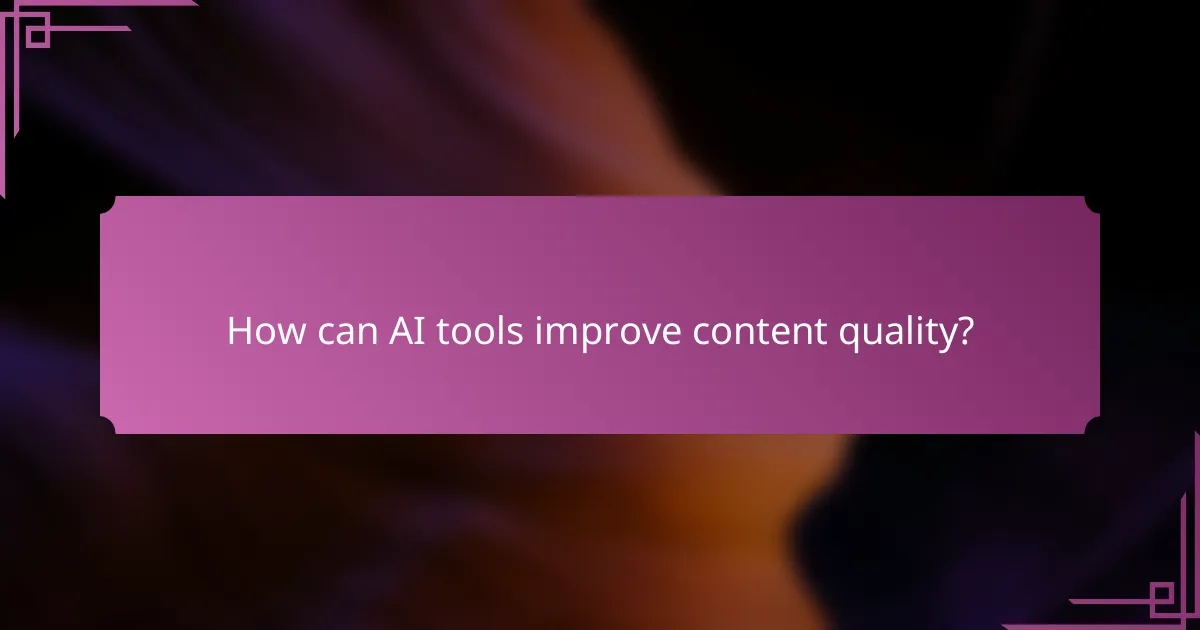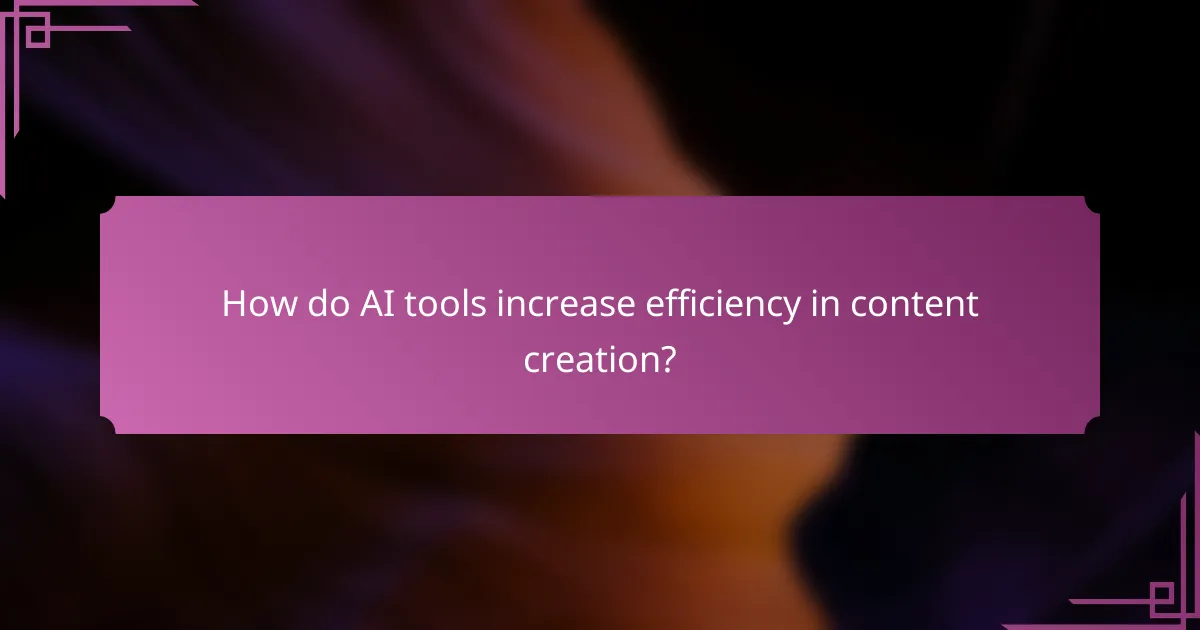AI tools are revolutionizing the way content is created and managed by enhancing quality, streamlining processes, and boosting efficiency. By automating repetitive tasks and integrating various applications, these tools enable writers and businesses to produce engaging, error-free content while focusing on strategic creativity. With advanced features for grammar improvement and search engine optimization, AI tools are essential for anyone looking to elevate their content and productivity.

How can AI tools improve content quality?
AI tools enhance content quality by providing advanced features that improve grammar, optimize for search engines, and automate proofreading. These tools help writers produce clearer, more engaging, and error-free content efficiently.
Enhanced grammar and style with Grammarly
Grammarly enhances grammar and style by analyzing text for errors and suggesting improvements. It checks for common mistakes such as punctuation errors, subject-verb agreement, and word choice, allowing writers to refine their work easily.
Using Grammarly’s browser extension or desktop application, users receive real-time feedback as they write. This immediate assistance helps maintain high standards of clarity and professionalism in various types of content, from emails to blog posts.
Content optimization using Surfer SEO
Surfer SEO optimizes content by analyzing top-ranking pages and providing data-driven recommendations. It focuses on key factors such as keyword usage, content length, and structure to help writers create articles that rank higher in search engine results.
By utilizing Surfer SEO’s guidelines, writers can ensure their content is aligned with current SEO best practices. This tool also offers insights into competitor strategies, allowing users to adjust their approach for better visibility and engagement.
Automated proofreading with ProWritingAid
ProWritingAid automates proofreading by offering in-depth analysis of writing style, grammar, and readability. It identifies issues like repetitive phrases, overused words, and sentence structure problems, enabling writers to polish their content effectively.
This tool provides detailed reports that highlight areas for improvement, making it easier for users to enhance their writing skills over time. ProWritingAid is particularly useful for longer documents, where manual proofreading can be time-consuming and less effective.

What are the best AI tools for integration?
The best AI tools for integration streamline processes and enhance productivity by connecting various applications and services. These tools help automate workflows, manage marketing efforts, and facilitate team communication, making them essential for businesses looking to improve efficiency.
Zapier for workflow automation
Zapier is a powerful tool that automates repetitive tasks by connecting different applications. It allows users to create “Zaps,” which are automated workflows that trigger actions in one app based on events in another. For example, you can set up a Zap to automatically save email attachments from Gmail to Dropbox.
When using Zapier, consider the number of integrations available, as it supports thousands of apps across various categories. A common pitfall is overcomplicating Zaps; keep them simple to ensure reliability and ease of troubleshooting.
HubSpot for marketing integration
HubSpot offers a comprehensive platform for marketing integration, combining tools for email marketing, social media management, and customer relationship management (CRM). This integration allows businesses to track customer interactions and optimize marketing campaigns based on real-time data.
Utilizing HubSpot effectively requires understanding its tiered pricing structure, which ranges from free tools to premium features. Businesses should regularly review their usage to ensure they are leveraging the right tools for their needs and not overspending on unnecessary features.
Slack for team collaboration
Slack is a collaboration platform that enhances team communication through channels, direct messaging, and file sharing. Its integration capabilities allow users to connect tools like Google Drive, Trello, and more, creating a centralized hub for project management and communication.
To maximize Slack’s potential, establish clear guidelines for channel usage and encourage team members to integrate relevant apps. Avoid cluttering channels with excessive notifications by setting up custom alerts and using the “Do Not Disturb” feature during focused work periods.

How do AI tools increase efficiency in content creation?
AI tools enhance efficiency in content creation by automating repetitive tasks, streamlining workflows, and providing data-driven insights. This allows creators to focus more on strategy and creativity rather than mundane processes.
Time-saving features of Jasper AI
Jasper AI offers various time-saving features that help content creators generate high-quality text quickly. Its templates and pre-set commands allow users to produce blog posts, social media updates, and marketing copy in just a few minutes.
Additionally, Jasper’s ability to understand context and tone means that users can create tailored content without extensive revisions. This can significantly reduce the time spent on editing and refining drafts.
Content scheduling with Buffer
Buffer simplifies content scheduling by allowing users to plan and automate their social media posts across multiple platforms. This means that content creators can set up their posts in advance, ensuring consistent engagement without needing to be online at all times.
With features like analytics and optimal posting times, Buffer helps users maximize their reach and engagement, making it easier to manage multiple accounts efficiently. This can save hours each week that would otherwise be spent on manual posting.
Streamlined research using Copy.ai
Copy.ai streamlines the research process by generating content ideas and outlines based on user prompts. This allows creators to quickly gather inspiration and structure their work without extensive background research.
Moreover, Copy.ai can assist in generating keywords and SEO-friendly phrases, which can enhance content visibility. By leveraging these features, users can reduce the time spent on research and focus on crafting compelling narratives.

What criteria should be used to select AI tools?
When selecting AI tools, consider factors such as cost-effectiveness, user-friendliness, integration capabilities, and the specific needs of your project. These criteria help ensure that the chosen tools deliver value and enhance productivity without overwhelming users.
Cost-effectiveness analysis
Cost-effectiveness analysis involves evaluating the financial implications of AI tools relative to their benefits. Look for tools that provide a clear return on investment, ideally reducing operational costs by a significant percentage while improving efficiency.
Compare subscription models, one-time fees, and potential hidden costs such as maintenance or training. For instance, tools priced in the low hundreds of USD per month may be more beneficial than those with higher upfront costs if they offer superior features and support.
User-friendliness evaluation
User-friendliness is crucial for ensuring that team members can effectively utilize AI tools without extensive training. Assess the interface design, ease of navigation, and availability of customer support to gauge how intuitive a tool is.
Conduct trials or demos to observe how quickly users can adapt to the tool. A user-friendly AI tool should allow new users to perform basic functions within a few minutes, minimizing the learning curve and maximizing productivity from the start.

How do AI tools impact SEO performance?
AI tools significantly enhance SEO performance by automating data analysis and optimizing content strategies. They help identify trends, improve keyword targeting, and streamline content creation, ultimately driving more organic traffic to websites.
Keyword analysis with SEMrush
SEMrush provides comprehensive keyword analysis that helps users identify high-potential keywords for their SEO strategies. It offers insights into search volume, keyword difficulty, and competitive density, allowing marketers to prioritize keywords that can yield the best results.
To effectively use SEMrush for keyword analysis, start by entering a seed keyword to generate a list of related keywords. Focus on long-tail keywords with lower competition, as they often convert better and are easier to rank for. Regularly updating your keyword list based on performance metrics is crucial for ongoing optimization.
Content gap identification using Ahrefs
Ahrefs excels in identifying content gaps by comparing your website’s content against competitors. This tool highlights topics that your competitors rank for but you do not, providing valuable opportunities to expand your content strategy.
To leverage Ahrefs for content gap analysis, use the “Content Gap” feature to input your domain and those of your competitors. Analyze the results to discover keywords and topics that are missing from your site. Prioritize creating high-quality content around these gaps to improve your SEO performance and attract more visitors.

What are the emerging trends in AI tools for content?
Emerging trends in AI tools for content focus on enhancing efficiency, improving quality, and integrating advanced technologies. Key developments include AI-generated video content, voice search optimization, and predictive analytics, each offering unique advantages for content creators and marketers.
AI-generated video content with Synthesia
Synthesia is revolutionizing video production by allowing users to create AI-generated videos quickly and cost-effectively. This tool uses advanced algorithms to generate realistic avatars that can speak in multiple languages, making it ideal for global outreach.
When using Synthesia, consider the type of content you want to produce. Short promotional videos or training materials can be created in a fraction of the time compared to traditional methods. However, ensure that the scripts are engaging and tailored to your audience for maximum impact.
Voice search optimization with Voiceflow
Voiceflow is a powerful tool for optimizing content for voice search, which is increasingly important as more users rely on voice-activated devices. This platform allows creators to design conversational experiences that enhance user engagement and improve search visibility.
To effectively use Voiceflow, focus on natural language processing and user intent. Create content that answers common questions and uses keywords that align with how people speak. Regularly update your voice applications to adapt to changing trends and user preferences.
Predictive analytics for content strategy
Predictive analytics tools help content creators anticipate audience behavior and preferences, enabling more effective content strategies. By analyzing data patterns, these tools can provide insights into what topics will resonate with your target audience.
When implementing predictive analytics, prioritize data quality and relevance. Use insights to inform your content calendar and tailor your messaging. Regularly review analytics to refine your approach and stay ahead of trends, ensuring your content remains relevant and engaging.

How will AI tools shape the future of content marketing?
AI tools are set to revolutionize content marketing by enhancing efficiency, personalization, and overall content quality. They enable marketers to analyze data, automate processes, and create tailored content that resonates with target audiences.
Integration of AI tools in content marketing
Integrating AI tools into content marketing involves using software that can analyze consumer behavior, automate content creation, and optimize distribution channels. This integration allows marketers to streamline workflows and focus on strategic decision-making rather than repetitive tasks.
For example, AI-driven platforms can analyze user engagement metrics to suggest content topics that are likely to perform well. Marketers can leverage these insights to create more relevant and appealing content, ultimately improving audience engagement.
Efficiency gains through AI
AI tools significantly enhance efficiency by automating various aspects of content marketing, such as scheduling posts, optimizing SEO, and personalizing email campaigns. By reducing the time spent on these tasks, marketers can allocate resources to more creative and strategic initiatives.
For instance, AI can generate content drafts based on specific keywords or themes, allowing marketers to refine and finalize them quickly. This can cut content production time by up to 50%, enabling faster go-to-market strategies.
Improving content quality with AI
AI tools improve content quality by providing insights into audience preferences and content performance. They can analyze large datasets to identify trends and suggest adjustments that enhance readability, engagement, and relevance.
Using AI-driven writing assistants can help ensure that content is not only grammatically correct but also aligns with brand voice and audience expectations. This leads to higher-quality outputs that resonate more effectively with consumers.


